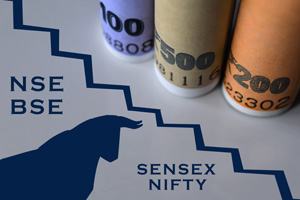
Do you know the difference between Nifty and Sensex indexes? If you are thinking of investing in the equity market, then it is important to know the difference between Nifty and Sensex. You can also invest in mutual funds by way of an equity fund, debt funds or hybrid funds, through the SIP or systematic investment plan and lumpsum routes. But, if you are keen on investing directly in stocks, then the Sensex vs Nifty and the Nifty 50 vs Sensex equations are aspects you need to keep in mind. Here is everything you need to know about Sensex vs Nifty returns and the Sensex vs Nifty chart.
Understanding Nifty and Sensex
The Sensex and Nifty are the two most significant indices in the Indian stock market, serving as benchmarks against which other indices and stocks measure their performance. While there are notable similarities, understanding the difference between Nifty and Sensex is crucial for investors. The Nifty, or National Stock Exchange Fifty, represents the top 50 stocks from nearly 1600 actively traded companies across 24 sectors in the National Stock Exchange (NSE), accounting for about 65% of the total free-float market capitalisation [1]. In contrast, the Sensex, also known as the S&P BSE Sensex, is the Bombay Stock Exchange’s (BSE) market index. Established in 1986 and initially following a weighted market capitalisation method, the Sensex shifted to a free-float methodology in 2003 [2]. It comprises a different set of companies compared to the Nifty and uses 1978-79 as its base year for calculation, unlike Nifty's varied selection, illustrating a critical aspect of the Nifty vs Sensex comparison. Accordingly, there are similar differences in the Sensex vs Nifty index fund as well, thereby offering investors the chance to invest in the scheme and index most aligned with their requirements.
[1] https://groww.in/p/difference-between-nifty-and-sensex
[2] https://groww.in/p/difference-between-nifty-and-sensex
How to Calculate Nifty?
You can calculate the Nifty index by leveraging the free-float market capitalisation weighted methodology, wherein the metric considers the total market value of the Nifty constituents, in relation to the index’s base period, which has been ascertained as November 3, 1995. The formula for arriving at the calculation of the Nifty index is – Market Capitalisation = Outstanding Shares X Price, and for this equation, you can derive the index constituents’ market capitalisation by multiplying their total number of outstanding shares with their current share prices. You can also calculate the index’s free-float market capitalisation by multiplying the Investable Weight Factor or IWF with the original market cap of Nifty. The term IWF refers to the quantity of shares not held by promoters or directors of the company. These shares can be freely traded on the stock market. Accordingly, Free-float market Capitalisation = Market capitalisation x IWF. Investors can finally arrive at the index value by using the following formula – Index Value = (Current Market Value/Base Market Capital) X 100. The value of the Nifty index depicts the returns that you stand to gain, when you invest in the index’s constituent stocks. Please note that the base market capital of Nifty stands at INR 2.06 trillion [3].
[3] https://groww.in/p/difference-between-nifty-and-sensex
How to Calculate Sensex?
Like Nifty, the Sensex uses a free-float market capitalisation method for its calculation, mirroring the total market value of its 30 constituent companies against the base period of 1978-79. The process begins with determining each company's market capitalisation, followed by adjusting this figure with a free-float factor, thus obtaining the Free-float Market Capitalisation (Market Capitalisation x Free-float Factor). To derive the Sensex value, this free-float market capitalisation is divided by an index divisor set at 100 (Index Value = Free-float Market Capitalisation / Index Divisor). This divisor not only aligns the base and current periods but also enables comparison across different times. Consequently, like Nifty, the Sensex offers an insight into the potential returns from investing in that portfolio, allowing investors to compare the performance of Sensex and Nifty.
What is the Difference Between Sensex and Nifty?
Now that you know the varied aspects governing the two indexes, let us take a look at the major difference between Nifty and Sensex. Firstly, the full-form of the Nifty is National and Fifty, while Sensex is the abbreviation for Sensitive and Index. In terms of aliases, the Nifty is also known as the Nifty 50 or S&P CNX Fifty, while the Sensex is also called the S&P BSE Sensex. Further, the Nifty index is owned and managed by the IISL, a subsidiary of the NSE, while the Sensex is owned by the BSE. The Sensex has a base number of 100 and base period of 1978-79, as against the Nifty’s base number of 1000, and base period of November 3, 1995. The Sensex does not have a base capital but the Nifty has one – INR 2.06 trillion. Other differences include the fact that the Nifty 50 index encompasses the top 50 companies under active trade on the NSE while the Sensex encompasses the top 30 companies on the BSE. Finally, the Nifty has a wider market appeal, as it covers a total of 24 sectors, as against the 13 sectors covered by the Sensex [4].
[4] https://groww.in/p/difference-between-nifty-and-sensex
Given that the two major indexes have these notable differences between them, it becomes easier for investors to pick the right benchmark for their requirements. Which index will you be investing in?
An investor education initiative by Edelweiss Mutual Fund
All Mutual Fund Investors have to go through a one-time KYC process. Investors should deal only with Registered Mutual Fund (RMF). For more info on KYC, RMF and procedure to lodge/redress any complaints, visit - https://www.edelweissmf.com/kyc-norms
MUTUAL FUND INVESTMENTS ARE SUBJECT TO MARKET RISKS. READ ALL SCHEME-RELATED DOCUMENTS CAREFULLY
Trending Articles
MUTUAL FUND INVESTMENTS ARE SUBJECT TO MARKET RISKS, READ ALL SCHEME RELATED DOCUMENTS CAREFULLY.















